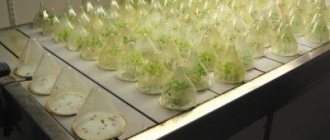When to plant phlox
Planting phlox in open ground in spring should be early. When the snow has already melted and the soil has not yet dried out too much.
- For the southern regions, this period falls at the end of March - mid-April.
- The middle zone plants phlox at the end of April.
- The northern regions are waiting for the end of April and beginning of May.
The Paniculate variety is loved to be grown in Russia.
It is important to know! The time period for planting phlox in the spring is two weeks, until the stems begin to actively grow.
Planting dates in autumn
The advantage of autumn planting is the length of planting time - up to 40 days. The plant gives all its strength to root growth, and next spring the phloxes bloom fully. Whereas after spring planting, in summer flowering may be delayed or completely absent.
Autumn planting can begin immediately after the formation of renewal buds. Each plant has its own planting calendar. Usually this is the end of August - beginning of September. Late-flowering varieties are planted from mid-September to the end of October.
What to do if the recommended planting dates have passed
Domestic phlox tolerate transplanting and dividing the tuber even in summer and in a blooming state. During this procedure, it is important not to damage the roots, and to water the planted cuttings regularly.
If the late planting occurs in the fall, it is important to protect the young roots from the cold. To do this, the seedlings are mulched with straw, sawdust, and peat.
Mulch in the hands of a gardener.
It is important to know! In winter, phlox should not be covered with materials that do not allow air to pass through. The plant withers and dies.
Phlox care
Simple care will provide excellent results. You will need to weed the flowers in time. This must be done carefully, since the root system is located close to the surface. Sufficient watering and fertilizing will be required. You can treat diseases and pests.
How to feed
Properly applied fertilizing will provide excellent results. The bush will be powerful, evenly covered with foliage. The flowers will be large and the inflorescences will be dense. Feeding begins when the first bud awakens until the life cycle is completed.
These flowers are perfectly fertilized with manure or peat. Manure will provide a sufficient amount of carbon dioxide, create good conditions for microorganisms, and improve the physical properties of the soil. More manure is needed if the soil is looser.
In autumn it is better to use horse manure. It warms the soil well. In spring, cow dung is more suitable.
Peat is added before planting. It is an excellent mulching agent for the soil, which prevents freezing.
Watering and loosening
The soil must be kept moist. If there is no precipitation, you need to water regularly. In this case, the soil must be loosened.
Loose soil gives oxygen access to the roots and creates conditions for eliminating weeds. During the season you will have to loosen the soil at least 6 times. In the second half of the season, it is recommended to carry out hilling to stimulate root development.
Wintering and shelter
In the absence of a sufficient amount of snow, even at minus 10 degrees, the growth buds will die in two weeks. And at minus 20 degrees the spine will freeze completely. If the snow lies in a layer of 50 cm, even thirty-degree frosts will not affect the condition of the phloxes. Shortly before the onset of frost, phloxes are covered with a layer of mulch 8-12 cm thick. Organic material will also serve as fertilizer.
How to choose healthy planting material
When is the best time to plant roses in open ground?
In garden centers it is possible to purchase greenhouse varieties of low-ornamental varieties. They were brought from Europe and during the delivery process their root system most often dries out. Such seedlings take a very painful and long time to acclimatize. In appearance, they begin to approach the image on the packaging after 2-3 years of life in the garden and with very careful care.
Healthy and well-growing seedlings will be available to local flower lovers. It is important that they were grown in the same conditions, which means that it will be much easier to take root in a new place.
A phlox baby should have 4-5 healthy green shoots up to 10 cm long. The roots should not be dry, free from stains and rot. The root system should be shortened to 15 cm.
Delenka
A cutting of a phlox bush sold in the fall should have 2-3 stems, thick and green. Healthy roots up to 15 cm long, which already contain renewal buds.
Phlox planting material is a bunch of roots with sprouted buds. Their shoots should be green and thick. The roots should not be dry, damaged or showing signs of rot. Their length should not exceed 15 cm.
Pests and diseases
Proper care will completely solve all problems with phlox, since they have excellent immunity. But mistakes when growing can lead to trouble.
In the absence of sufficient lighting and nutrition, diseases arise. They are immediately visible. All varieties can be affected by powdery mildew or rust, white verticillium wilt, spotting, mosaic, variegation, shredding of leaves and faded flowers.
The most dangerous is the stem nematode. It leads to curling and thinning of the shoots in the upper part. If the pest affects most of the flower, it dies.
Methods of controlling nematodes:
- infected areas of the plant are cut and burned;
- the sprouts are transplanted;
- at the end of spring cuttings are carried out;
- nasturtiums and marigolds are planted in the infected bed.
Powdery mildew in the form of a white coating affects shoots and leaves. Later the plaque turns black and the leaves wither. Most often, the disease appears in the fall.
Methods to combat powdery mildew:
- Spray the leaves with a mixture of soda ash, potassium permanganate and soap dissolved in water;
- Spray the leaves with products that contain copper - “Hom”, “Oxyhom”.
Verticillium wilt occurs as a result of the action of a fungus in the root system of a plant. As a result, the leaves wither and lose color. Fighting the disease:
- soil treatment with lime mortar;
- removal of affected plants along with the soil;
- treatment of cuttings with Gamair or Maxim.
Soil preparation
The composition of the soil for phlox is a very important point in caring for these beauties.
How to plant roses in open ground in summer
The soil for planting is prepared six months in advance:
- the selected area should be cleared of debris and weeds;
- the area needs to be dug up several times to make the soil crumbly;
- since phlox roots grow to a depth of 30 cm, soil cultivation should be no less than this depth.
Depending on the type of soil, various additives are needed:
- Clay soil needs coarse sand, lowland peat, humus, compost, lime, and mineral fertilizers.
- To loose soil you need to add clay soil, turf soil, humus, compost and mineral fertilizers.
It is important to know! During planting, fertilizers are added to the hole. Phosphorus-potassium during autumn planting and nitrogen-containing in the spring.
P. G. Gaganov Perennial Phlox Chapter 2, § 2
During the growing season, phlox forms a large number of stems, leaves and flowers, and therefore they annually extract a lot of nutrients and moisture from the soil.
The existing opinion that phloxes are undemanding plants is not entirely correct. This opinion was formed, apparently, because phlox are very resilient plants and tolerate both insufficient care and average soil quality. First of all, you should pay attention to the need to systematically maintain soil moisture. It should be such that the plants are provided with moisture for the entire growing season. If the soil is loose and well fertilized, but not provided with moisture, then the proper decorative effect will not work.
On dry soils, phlox stems grow shorter, fewer inflorescences are formed and the flowers are small; The plant blooms earlier and ends flowering quickly. If there is a lack of moisture, the plant cannot fully use the reserves of nutrients available in the soil. Moreover, the high content of mineral salts in the soil, which is beneficial for the plant with sufficient soil moisture, turns out to be harmful in dry soil, since the concentration of salts in the soil increases with a lack of water, which has a harmful effect on the development of plants. This phenomenon is expressed in the browning of the lower leaves on the stems, their premature drying out and falling off; the plants look depressed.
On heavy, structureless clay soils, especially those susceptible to the drying effects of the sun and winds, the bushes develop very poorly. Without adding a sufficient amount of sand, compost, peat or other organic fertilizers and liming, heavy clay soils are of little use for phlox cultivation. Sandy soils without the addition of clay and organic fertilizers are also unsuitable for phlox cultivation.
The bushes develop well and bloom profusely in areas shaded from midday sunlight, with sandy loam, moist soils when filled with organic and mineral fertilizers and 3-4 liquid fertilizers during the summer.
Phlox bushes develop well on medium-loamy, loose, nutritious and sufficiently moist soils. The acidity of the soil should be close to neutral (pH about 7), however, phloxes tolerate acidified soils quite well (pH = 5.5-0). With high soil alkalinity (pH = 9-10), the bushes have a depressed appearance and develop poorly. The addition of semi-decomposed horse manure or leaf humus, loose forest litter, various composts with the addition of ash, bone meal, saltpeter and superphosphate into the loamy garden soil (25-30% of the volume of the improved layer) before planting has a particularly good effect on growth and flowering.
Manure and other organic fertilizers make the soil loose and, as a result, breathable and retain moisture well, enrich the soil with nitrogen, phosphorus and potassium. At the same time, the nutrients in organic fertilizers are consumed gradually, which is very important for perennial plants. Organic fertilizers are best applied to the soil together with mineral ones.
It is known that the bulk of phlox roots are located at a depth of 3 to 15 cm, therefore there is no need to fertilize the soil to a depth of more than 20-25 cm. Laying manure or humus in a continuous layer to a depth of 20-25 cm (as is sometimes done) is not only useless, but also harmful, since the resulting layer separates the upper layers of soil from the subsoil and thereby interferes with the free access of subsoil moisture to the roots.
It is not recommended to introduce sawdust and shavings into the soil, since they carry a large number of pathogens of fungal diseases. In addition, cellulose-decomposing bacteria, settling on sawdust, need a large amount of nitrogen, which they absorb from the soil. As a result, plants experience nitrogen starvation. In the same way, moldy manure containing a large amount of sawdust should not be introduced. It is better to prepare compost from such manure by adding feces and peat. After 1-2 years, all this will decompose well, and compost can be added to the soil.
Depending on its origin, peat has a different composition. The peat of raised (moss) bogs is acidic and contains few nutrients (nitrogen 1%, phosphorus 0.1%, potassium 0.05-0.15%), the peat of lowland (meadow) bogs is less acidic, it usually contains more nitrogen (2 -3%). The nutrients in peat can be used by plants only when it is well decomposed, and peat decomposes very slowly. Therefore, it is better to use it as a component in the production of composts.
Wood ash is a valuable fertilizer for phlox. Its application increases the brightness of flowers, and plants are less susceptible to diseases. In addition to potassium, the ash contains lime. The dose of ash is 100-200 g per 1 sq. meter.
In addition to the above fertilizers, sand and fluff lime are added to heavy clay or silty soils; the latter is given at the rate of 250-300 g per 1 sq. m. Instead of lime, you can use crushed plaster, ground limestone, which is taken 1.5-2 times more than lime.
If farms have heavy clay, silty and podzolic soils, they should be improved 1-2 years before planting phlox. In such areas, row crops (root crops, potatoes) are planted, during which the soil is fertilized. Before planting phlox in such soil, you will need to apply approximately the same doses of fertilizer as are applied on loamy cultivated soils.
In small areas and individual gardens, clay and sandy soils can be improved in other ways. If you decide to plant phlox in the spring, the soil must be dug up the previous year, in August - September, adding organic fertilizers (humus, peat, compost), as well as sand and lime - on clay soils and clay - on sandy soils. In the spring, as soon as the soil is ripe for cultivation, the area is dug up a second time, thoroughly mixing the soil to a depth of 20-25 cm, destroying lumps, and evenly distributing organic fertilizers. Sometimes one spring digging is not enough and soil treatment has to be repeated 1.5-2 weeks after the first.
If, when digging in the spring, it turns out that last fall little organic fertilizer was given to the soil, they are added during spring tillage, adding, in addition, full mineral fertilizer.
Before planting phlox, it is recommended to apply peat-fecal and other composts containing feces, as they have a very beneficial effect on growth, cause abundant flowering, and increase the vitality of plants.
Virgin soil is also dug up or plowed in the fall to a depth of 20-25 cm, with the formation being turned over and the turf being crushed into small pieces. If the soil is sufficiently prepared, in the spring this area is used for planting phlox, adding organic and mineral fertilizers to the soil, as is done when preparing loamy soils. If the soil is not sufficiently cultivated, it is used for one year for garden crops. When pre-cultivating a site, it is good to sow legumes that enrich the soil with nitrogen.
Cultivated soils for spring planting of phlox are also prepared in the fall by digging them to a depth of 25 cm and adding semi-decomposed manure or other organic fertilizers. On loamy soils, 1-1.5 buckets of such fertilizers should be applied per 1 square meter. meter.
On acidic podzolic soils, the dose of manure must be increased slightly and lime must be added at the same time (200-300 g per 1 sq. m). It’s good to give bone meal (100-150 g) and stove ash (100-200 g per 1 sq. m) during digging.
In the spring, mineral fertilizers are applied: 30 g of ammonium nitrate, 50-60 g of superphosphate, 30 g of potassium salt. In terms of the active substance of fertilizers (nitrogen, phosphoric acid and potassium oxide), the indicated doses are approximately 10 g of each nutrient.
It is recommended to use factory granulated superphosphate, which lasts longer than powdered superphosphate. A mixture of superphosphate with compost or humus also turns out to be much more effective than the same substances, but each added separately. To prepare such a mixture, take 4-5 parts of compost (humus) and 1 part of superphosphate by weight. Granular superphosphate and organomineral fertilizers are especially effective on podzolic soils.
When using a mixture of composts with superphosphate, the amount of pure humus added to the soil before planting can be reduced by about one third. When adding compost prepared with phosphate rock, the amount of powdered superphosphate can be reduced by half.
Different soils require different amounts of fertilizer. The nutrient content of the soil is determined by soil analysis; the missing amount of these substances is added.
For medium loamy cultivated soils, the doses of fertilizers are indicated above; for chernozem soils and soils well supplied with nitrogen, the dose of nitrogen fertilizers should be reduced to 6-8 g of active substance, potassium to 9-10 g, and the dose of phosphorus should be increased to 12 g of active substance per 1 sq. m.
On podzolic soils and soils poor in organic matter, nitrogen fertilizers need to be applied at 13-14 g of active substance per 1 square meter. m, and the doses of phosphorus and potassium can be the same as for medium loamy soils.
Commercially available mineral fertilizers contain approximately the following amounts of active ingredient:
| Name | Amount of substance, % | Substance |
| Ammonium sulfate | 20-12 | nitrogen |
| Ammonium nitrate | 30-34 | nitrogen |
| Sodium nitrate | 16 | nitrogen |
| Urea | 46 | nitrogen |
| Simple superphosphate | 16-20 | phosphoric acid |
| Double superphosphate | 45-50 | phosphoric acid |
| Precipitate | 38 | phosphoric acid |
| Potassium chloride | 50-54 | potassium oxide |
| Potassium salt | 30-40 | potassium oxide |
| Potassium sulfate | 45-50 | potassium oxide |
When adding nitrogen, phosphorus and potassium to the soil in the form of mineral fertilizers, it is necessary to know the percentage of active substance in these fertilizers.
To calculate how much of a given mineral fertilizer needs to be added to the soil, the recommended amount of active ingredient must be multiplied by 100 and the results divided by the percentage of active ingredient in the given fertilizer. For example, if it is recommended in the soil for 1 sq. Add 10 g of nitrogen in the form of ammonium sulfate (and we know that ammonium sulfate contains 20% nitrogen), recalculate: 10x100:20. Therefore, for fertilizer you need to take 50 g of ammonium sulfate.
When digging the soil, it is advisable to place fertilizers in the upper 2/3 of the arable layer and mix well with the soil. During this work, it is necessary to carefully select rhizomes of weedy perennial grasses from the soil, as well as stones, and remove them from the site. It is especially dangerous to leave the rhizomes of wheatgrass, cowgrass and bindweed in the soil. Intertwined with the roots of phlox, the rhizomes of these weeds grow through the bushes and cannot be removed by any means. The only way to get rid of them is to dig up the phlox bushes and pick out the weed rhizomes from the soil and bushes.
If phlox is planted in the fall, the soil should be prepared 1-2 weeks before planting. As with spring planting, organic fertilizers, bone meal, ash, superphosphate, and if the soil is acidic, then lime are added to the soil. Potassium salt and nitrate are applied in early spring of next year, embedding them in the top layer of soil during spring loosening.
In the Botanical Garden of Moscow State University, experiments were carried out for a number of years to determine the effect of mineral fertilizers on the development of phloxes and the increase in their decorative qualities (E. Z. Mantrova. Phloxes. Publishing house of the Ministry of Public Utilities of the RSFSR, 1959).
The influence of various nutrients on the flowering of phlox (Panama variety)
Table 1
| Experience Options | Beginning of flowering | End of flowering | Flowering period (days) | Number of flowers on a bush | Diameter of the main inflorescence | Number of flower stems per bush | ||
| in pcs. | V % | in pcs. | V % | |||||
| Control | 1/Aug | 16/Sep | 46 | 138 | 100 | 12,7 | 100 | 1 |
| N | 20/Jul | 16/Sep | 56 | 433 | 313,8 | 15,2 | 119,7 | 14 |
| P | 2/Aug | 14/Sep | 42 | 201 | 151,5 | 12,4 | 97,2 | 7 |
| K | 1/Aug | 16/Sep | 46 | 257 | 186,2 | 14 | 110,2 | 5 |
| N.K. | 20/Jul | 12/Sep | 52 | 470 | 340,6 | 15,9 | 125,2 | 13 |
| PK | 28/Jul | 10/Sep | 42 | 270 | 195,7 | 14,8 | 108,7 | 8 |
| NPK | 20/Jul | 10/Sep | 50 | 433 | 313,8 | 18,9 | 144,4 | 23 |
The work was carried out both in open ground and in growing vessels. The soil's mechanical composition was medium loamy, its acidity was close to neutral (pH=7.3), the content of phosphoric acid was 40-50 mg and potassium oxide was 4.8-6 mg per 100 g of soil.
Nitrogen, phosphorus and potassium were added to the soil before planting. At the same time, they were used both in the form of separate batteries and together. Application doses are 90-120 kg per 1 ha, or 9-12 g per 1 sq. m of active ingredient of each nutrient. The following fertilizers were used: ammonium sulfate, superphosphate and potassium chloride. Similar experiments were carried out with another variety - Kolkhoznitsa. The results of experiments with this variety are given in Table 2.
The influence of fertilizers on the intensity of flowering of phlox (Kolkhoznitsa variety)
table 2
| Experience Options | Start | Inflorescence diameter | Number of flowers per plant | |||
| budding | flowering | in cm | in % to control | in pcs. | in % to control | |
| Control | 25/Jul | 1/Aug | 9,6 | 100,0 | 47,6 | 100,0 |
| N | 15/Jul | 20/Jul | 15,6 | 162,5 | 206,0 | 432,8 |
| P | 15/Jul | 20/Jul | 11,5 | 119,8 | 95,0 | 199,7 |
| K | 18/Jul | 28/Jul | 7,7 | 80,1 | 26,3 | 55,2 |
| N.K. | 16/Jul | 21/Jul | 13,8 | 143,8 | 168,5 | 354,0 |
| NP | 15/Jul | 20/Jul | 16,9 | 176,0 | 175,4 | 368,5 |
| PK | 25/Jul | 1/Aug | 10,5 | 109,4 | 37,0 | 77,7 |
| NP powder K | 15/Jul | 22/Jul | 16,0 | 106,7 | 237,0 | 443,3 |
| NP granules K | 15/Jul | 28/Jul | 17,1 | 178,1 | 211,0 | 497,8 |
| Manure | 16/Jul | 21/Jul | 11,7 | 121,9 | 90,6 | 190,3 |
As can be seen from Tables 1 and 2, the best decorative development of phlox was achieved when full mineral fertilizer was added to the soil before planting. In second place is nitrogen, the effect of which in the experiments presented turned out to be almost equal to the effect of complete mineral fertilizer. The addition of phosphorus alone or potassium alone and potassium with phosphorus together did not improve the decorative qualities of phloxes, and in some cases reduced them. Mineral nitrogen and complete mineral fertilizer applied before planting were more effective than manure. When nitrogen was added to the soil before planting, the number of flowers increased 3-4 times compared to unfertilized plants. In addition, nitrogen fertilizer accelerated the onset of flowering and increased its duration by about 10 days compared to the control. The diameter of the inflorescences has also increased significantly.
To establish doses of mineral fertilizers that contribute to obtaining the best decorative effect, 60, 90, 120, 180 and 240 kg of the active substance of each nutrient were applied per 1 ha on the same soils (Tables 3 and 4).
The data in tables 3 and 4 show that the highest decorative effect was achieved by adding 120 kg per 1 ha (12 g per 1 sq. m) of each nutrient to the soil or, in terms of mineral fertilizers, about 35 g of ammonium nitrate, 65 g superphosphate and 25 g potassium chloride per 1 sq. m.
The influence of different doses of fertilizers on the decorative qualities of phlox varieties Pink Pyramid
Table 3
| Experience Options | Number of main stems | Of these flowering | Number of additional stems | Diameter of inflorescences, cm | Total number of flowers | Total plant weight, g |
| Control (no fertilizer) | 3 | 3 | — | 9,6 | 451 | 115 |
| N60P60K60 | 6 | 6 | — | 13,1 | 772 | 179 |
| N90P90K90 | 9 | 6 | 13 | 14,6 | 971 | 275 |
| N120P120K120 | 6 | 6 | 10 | 17,3 | 1145 | 184 |
| N90P60K90 | 5 | 5 | — | 12,0 | 700 | 156 |
| N180P180K180 | 6 | 6 | 4 | 11,4 | 908 | 166 |
| N240P240K240 | 5 | 4 | 17 | 11,2 | 704 | 127 |
The indicated doses of fertilizers are recommended for application to the soil before planting on medium loamy soil varieties when planting with separated rhizomes. When planting with rooted cuttings, the fertilizer rate should be reduced to 9-10 g of the active substance of each element.
Increasing doses of fertilizers above 120 kg of active substance per 1 ha begins to inhibit plants and, at very high doses, leads to their death.
The influence of different doses of fertilizers on the decorative qualities of phlox varieties Pamyati Chkalova
Table 4
| Experience Options | Number of main stems | Of these flowering | Diameter of inflorescences, cm | Total number of flowers | Beginning of flowering | End of flowering | Flowering period | Plant height, cm | Total plant weight, g |
| Control (no fertilizer) | 3 | 3 | 12,5 | 255 | 21/Jul | 23/Aug | 32 | 56 | 77 |
| N60P60K60 | 9 | 4 | 16,0 | 264 | 19/Jul | 23/Aug | 34 | 16 | 153 |
| N90P90K90 | 7 | 7 | 11 | 295 | 17/Jul | — | — | 50 | 180 |
| N120P120K120 | 8 | 5 | 13,5 | 310 | 18/Jul | 23/Aug | 34 | 54 | 190 |
| N90P60K90 | 19 | 4 | 12,5 | 233 | 19/Jul | 22/Aug | 33 | 55 | 134 |
| N240P240K240 | 10 | 4 | 13,0 | 307 | 21/Jul | 20/Aug | 29 | 53 | 124 |
| N180P180K180 | 5 | 5 | 9,3 | 447 | 20/Jul | 22/Aug | 32 | 59 | 122 |
The data presented in the tables referred to medium loamy soils with a high phosphorus content. On chernozem soils, the dose of fertilizer should be reduced to 60-90 kg per 1 ha; on podzolic soils, on the contrary, the dose may be higher. When applying organic fertilizers together with mineral fertilizers, the dose of the latter should be reduced.
The effect of fertilizers applied to the soil decreases from year to year, as phlox intensively consumes them. Therefore, in addition to basic fertilizers, annual feeding of phlox is necessary, which will be discussed below.
Previous part | Next part
Reproduction
When to plant hazel grouse: planting in autumn or spring
At the end of May, seeds are sown in the future flower bed. The soil needs to be moistened with warm water, the seeds should not be deepened too much (breeders recommend sowing without deepening on the surface of the soil).
After planting, the seeds need to be covered with film for several days. Next, maintain moisture by spraying, and after germination, reduce watering so that the young roots do not rot.
Growing annual phlox from seed varies slightly. The seed is first planted in containers under film in early spring, and in early May, the seedlings are ready for planting in open ground.
How to grow phlox from seeds
For successful propagation of phlox by roots, they need to have a supply of nutrients. This is either early spring or late autumn.
Autumn roots are cut by 2/3 and planted in boxes with nutritious soil, sprinkled with river sand on top. They need to spend the winter in cold and darkness. And in the spring, slowly increase the temperature and lighting. In May, the seedlings are ready to be transplanted into a schoolyard in open ground.
In spring, planting phlox with rhizomes is easier. How to plant phlox in the spring with roots so as not to harm the mother plant? You only need to cut the roots by 1/3. Then they are placed in pots and live in greenhouses at a temperature no higher than +10C, protected from light. After two weeks, the temperature is raised to +25C. The emerging sprouts are accustomed to the sun. Seedlings that have grown 10 cm are planted in a schoolyard in open ground.
You can divide a phlox bush in early spring or early autumn. The dug up bush is divided into pieces of several shoots.
Important! The main thing is that the roots contain active buds; without them, the division will die.
The process of dividing a phlox bush











